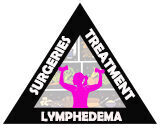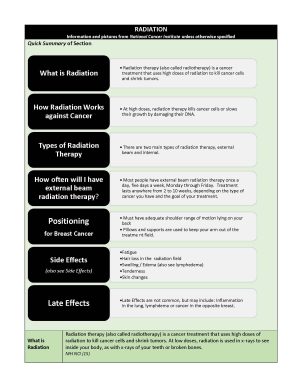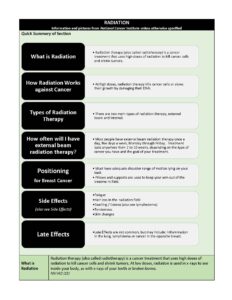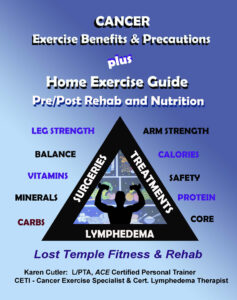What is
Radiation Therapy
Your Body is Your Temple
Research, Resources & Education
Table of Contents
Radiation therapy uses high energy radiation to destroy cancer cells, reducing the size of tumours. It's tailored to each patient and has other applications in healthcare, manufacturing and energy. X-rays are used for medical diagnosis. Radiation therapy is a life-saving treatment that enhances our quality of life.
How Radiation Works against Cancer
High Dose
DNA
How Long
Radiation Therapy Videos
YouTube Videos that help explain Radation Therapy for Cancer.
Disclaimer:
This is for research only and Lost Temple Fitness & Cancer does not endorse any video presented on this website.
It is advised that you ALWAYS CHECK WITH YOUR PHYSICIAN for a proper diagnosis and treatment plan.
Radiation Therapy
Types of Radiation Therapy
- External beam radiation therapy comes from a machine that aims radiation at your cancer. The machine is large and may be noisy. It does not touch you, but can move around you, sending radiation to a part of your body from many directions.
- External beam radiation therapy is a local treatment, which means it treats a specific part of your body. For example, if you have cancer in your breast, you will have radiation only to your chest/breast, not to your whole body.
- Internal radiation therapy is a treatment in which a source of radiation is put inside your body. The radiation source can be solid or liquid.
- Internal radiation therapy with a solid source is called brachytherapy.
- In this type of treatment, seeds, ribbons, or capsules that contain a radiation source are placed in your body, in or near the tumor.
- Like external beam radiation therapy, brachytherapy is a local treatment and treats only a specific part of your body.
- With brachytherapy, the radiation source in your body will give off radiation for a while.
Side Effects and Late Side Effects
- Fatigue
- Hair loss in the radiation field
- Swelling / Edema (also see lymphedema)
- Tenderness
- Skin changes (see below)
Late Effects are not common, but may include:
- Inflammation of the lung after radiation therapy to the breast, especially when chemotherapy is given at the same time.
- Arm lymphedema, especially when radiation therapy is given after lymph node dissection.
- In women younger than 45 years who receive radiation therapy to the chest wall after mastectomy, there may be a higher risk of developing breast cancer in the other breast.
Skin Changes
- Redness. Your skin in the treatment area may look as if you have a mild to severe sunburn or tan.
- Severe itching. The skin in your treatment area may itch very badly. It is important to avoid scratching, which can cause skin breakdown and infection. Skin breakdown is a problem that happens when the skin in the treatment area peels off faster than it can grow back.
- Dry and peeling skin. The skin in your treatment area can get very dry. It may get so dry that it starts to peel, as if you have had a bad sunburn. If it peels off faster than it can grow back, you may develop sores or ulcers.
- Moist reaction. The skin in your treatment area can become wet, sore, and infected. This problem is more common where you have skin folds, such as your buttocks, behind your ears, and under your breasts. It may also occur where your skin is very thin, such as your neck.
- Swollen skin. The skin in your treatment area may be swollen and puffy..
Radiation kills healthy skin cells in the treatment area. When people get radiation therapy almost every day, their skin cells do not have enough time to grow back between treatments. Skin changes can happen anywhere on the body that gets radiation.
- Skin changes may start a few weeks after you begin radiation therapy. Many of these changes go away a few weeks after treatment is over. But even after radiation therapy ends, some skin changes may remain.
- Skin in the treatment area may always look darker and blotchy.
- It may feel very dry or thicker than before.
- You will always burn quickly and be sensitive to the sun.
- Skin care. Take extra good care of your skin during radiation therapy. Be gentle and do not rub, scrub, or scratch in the treatment area. Use creams that your doctor or nurse suggests.
- Do not put anything on your skin that is very hot or cold. Do not use heating pads, ice packs, or other hot or cold items on the treatment area.
- Be gentle when you shower or take a bath. You can take a lukewarm shower every day. If you prefer to take a lukewarm bath, do so only every other day and don’t soak for too long. Whether you take a shower or bath, make sure to use a mild soap. Dry yourself with a soft towel by patting, not rubbing, your skin. Be careful not to wash off the ink markings that you need for radiation therapy.
- Use only those lotions and skin products that your doctor or nurse suggests. If you are using a prescribed cream for a skin problem or acne, tell your doctor or nurse before you begin radiation treatment.
- Check with your doctor or nurse before using any of the following skin products:
- Bubble bath
- Cornstarch
- Cream
- Deodorant
- Hair removers
- Makeup
- Oil
- Ointment
- Perfume
- Powder
- Soap
- Sunscreen
- Cool, humid places. Your skin may feel much better when you are in cool, humid places. You can make rooms more humid by putting a bowl of water on the radiator or using a humidifier. If you use a humidifier, be sure to follow the directions about cleaning it to prevent bacteria.
- Soft fabrics. Wear clothes and use bed sheets that are made of very soft fabrics.
- Do not wear clothes in your treatment area that are tight and do not breathe, such as girdles, body shapers, and pantyhose.
- Protect your skin from the sun every day. The sun can burn you even on cloudy days or when you are outside for just a few minutes.
- Do not go to the beach or sunbathe.
- Wear a broad-brimmed hat, long-sleeved shirt, and long pants when you are outside.
- Talk with your doctor or nurse about sunscreen lotions. He or she may suggest that you use a sunscreen with an SPF of 30 or higher.
- You will need to protect your skin from the sun even after radiation therapy is over.
- Do not use tanning beds. Tanning beds expose you to the same harmful effects as the sun.
- Adhesive tape. Do not put adhesive bandages or other types of sticky tape on your skin in the treatment area. Talk with your doctor or nurse about ways to bandage without tape.
- Shaving. Ask your doctor or nurse if you can shave the treatment area. If you can shave use an electric razor, but do not use a pre-shave liquid.
- Talk with your doctor or nurse. Some skin changes can be very serious. Your treatment team will check for skin changes each time you have radiation therapy. Make sure to report any skin changes that you notice.
- Medicine. Medicines can help with some skin changes. These include lotions for dry or itchy skin, antibiotics to treat infection, and drugs to reduce swelling or itching.
Disclaimer: The information in this book/website is for educational purposes only and has been obtained through research, publications and personal experience, and shall not be liable for incorrect information. Any mentioned publications or websites does not imply endorsement. As this industry is ever changing, I urge readers to confirm the information contained in this book/website. The author will not be liable for any injuries sustained from practicing techniques taught or for any typographical errors or omissions.
It is advised that you always check with your medical doctor or physical therapist before starting an exercise program or change in diet.
|
Information and pictures from National Cancer Institute unless otherwise specified |




